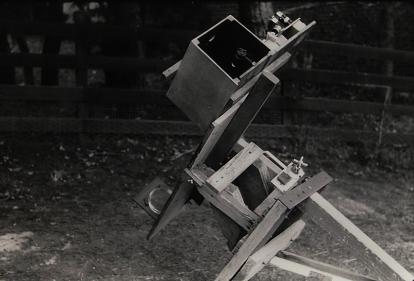
An earlier version of this material was published in the proceedings of the 11th NACAA conference held in Perth.
ABSTRACT
A program including radio and photographic observations of the Sun and visual auroral observations was undertaken from September 1981 to October 1982. The aim of the program was to establish if relatively simple radio measurements at metre wavelengths could usefully supplement an existing solar photographic and auroral programme. The radio equipment consisted of a versatile meridian transit radio telescope which was designed to record the variability in solar radio flux by performing daily measurements at 228 MHz, radio spectral measurements at 228 MHz and 138 MHz and polarization measurements at 138 MHz. A Newtonian reflector of open tube design. using an uncoated 15-cm diameter primary mirror and a shock mounted camera were used to obtain high resolution white light photoqraphs of the Sun. Visual auroral observations were carried out by a number of observers in Victoria, Tasmania and South Australia. From the data gathered over this period several types of radio bursts were identified: Type I emission associated with radio noise storms located in the corona above active sunspot regions. Type II radio bursts associated with magneto-hydrodynamic shock waves generated during large solar flares and Type III bursts generated during the rapid expulsion of electron streams from the solar surface during flares or sub-flares. From the daily measurements of solar radio flux, estimates of the 'Quiet Sun' coronal temperatures were made giving a value of 1.4 million Kelvin. The spectrometer measurements of Type III bursts gave an average electron stream radial velocity of 0.26 c for ten isolated bursts measured during the programme. Polarization measurements at 138 MHz showed only a small degree of polarization for these bursts whereas Type I storm bursts were often highly polarized with values exceeding 80%. It is concluded that radio observations can provide important information to aid in the prediction of aurorae since they give vital clues as to the high energy (invisible) phenomena occurring in the solar corona. When combined with visual and photographic observations a much more complete picture of Sun-Earth interactions can be established.
INTRODUCTION
Although many amateur astronomers periodically observe the Sun, very few have mastered the difficult art of solar photography and fewer still have ventured into the intricacies of radio observations. However, within our Society, we were fortunate enough to have the expertise to make not only these types of observations but also auroral observations. These circumstances led us to consider a joint solar observing programme which would combine the facilities of the Solar, Radio and Auroral Sections of the Society.
During the programme which extended over the period 1981 September to 1982 September we recorded our optical observations photographically on a weekly basis, we recorded the 228 MHz radio flux levels daily and collected auroral observations as they became available. Our aim was to explore the temporal relationship between the appearance of sunspots, the day to day changes in the intensity and type of solar radio emission and the appearance of the aurorae.
OPTICAL EQUIPMENT
Our equipment consists of a 15 cm Newtonian reflector with an effective focal length of 202 cm which was specifically designed for solar photography, and a multi-mode radio telescope designed to allow dual frequency observations of the radio Sun at 136 and 228 MHz, polarization measurements at 138 MHz, and interferometer operation at 228 MHz. Visual auroral monitoring is performed by observers in South Australia, Victoria and Tasmania who submit observations to the Society. As well as visual sightings some observers provide photographic records and use a short wave radio receiver to check for the presence of auroral flutter, which is a distinctive rapid fluctuation of radio signals caused by solar induced turbulence in the terrestrial ionosphere.
Conventional closed tube telescopes are generally unsuitable for solar photographic work for several reasons. Firstly, unless some form of filtering is used, the image of the Sun formed at the focal plane of the camera is so intense that the shutter can be damaged. Secondly, thermal effects generally attributed to the convective movement of the air immediately adjacent to the inside of the tube can cause image distortion due to anomalous refraction in the light path and thirdly, camera shutter vibration may be transmitted to the telescope mounting during exposure giving further image distortion. Of course this latter effect is a common problem with all astronomical photographic work.

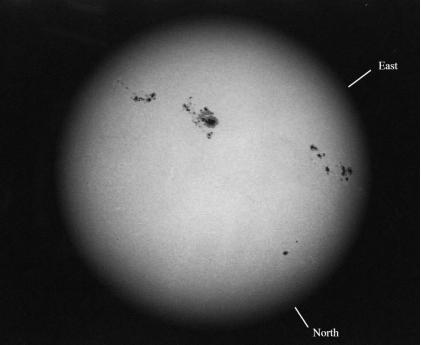
The first problem was tackled by using an uncoated primary mirror and a neutral-density filter (density 2.9) attached to the camera. Only about 4% of the incident light is reflected from the surface of the mirror and the neutral density filter further reduces the light intensity at the focal plane, so that typical exposure times of l/250th of a second can be used with fine grain films. Such short exposure times eliminate the need for tracking and also reduce the effect of air turbulence and telescope tube and mounting vibration.
Thermal effects can be reduced by using either an oversized tube, an open tube design or evacuating the air from the tube. In our case the open tube design was chosen and observations are made from a grassed location sheltered by trees which help to further stabilize the air around the telescope. We have found that the best results are achieved when photographs are taken two to three hours after sunrise, before appreciable heating of the telescope surroundings has occurred.
The amount of camera shutter vibration transmitted to the tube and mounting was considerably reduced by supporting the plate, to which the camera is attached, on four sponge rubber mounts. The success of this simple, but effective, technique for reducing tube shake is largely due to the removal of the rigid mechanical coupling between the eyepiece-holder and the camera. The only possible problem with such a system is that since the light path is open, extraneous light may enter the camera. This possibility is effectively eliminated by the neutral density filter, which reduces the extraneous light level to a point where it does not record on the film.
Using the telescope described we have been able to record consistently high quality photographs of the solar photosphere but we have never recorded a white light solar flare on film. This is not surprising since these events are extremely rare indeed. However, while the optical telescope is rather powerless to record solar flare-events without spcial (and expensive) filters tuned to the red spectral line of hydrogen alpha, the radio telescope can detect them with ease.
SOLAR RADIO BURSTS
A comprehensive description of solar radio emission is beyond the scope of this article but at metre wavelengths a classification scheme has been developed by solar radio astronomers which can be used to categorize bursts into five main types.
Type I bursts are short duration highly polarized bursts which have a duration of the order of one second and occupy a relatively narrow bandwidth of typically two percent of the observing frequency. They are usually superimposed on enhanced broad-band emission which is polarized in the same sense. It is the combination of the type I bursts and the enhanced emission which is referred to as a noise storm. These storms may last for hours or several days and are thought to be generated in storm centres in the corona above sunspot groups. The remaining burst classifications, Type II, III, IV and V are all generally associated with solar flare activity. Type II and III are the so-called slow and fast drift bursts generated during the expulsion of proton and electron streams respectively during the flare. The description 'drift burst' arises from the fact that these particle streams (referred to as exciters) excite progressively lower frequency radio waves as they travel out through the corona. Since the frequency of the radio waves is uniquely determined by the coronal electron density and magnetic field intensity at the point of generation, frequency versus time recordings of these bursts can be used to deduce the velocity and apparent height of the exciters in the solar atmosphere. This information is useful in the study of flare mechanisms.
There is considerable variability in the form of flare related radio emission. The full orchestration of a large solar flare perceived at metre wavelengths commences with a group of fast drift TYPE III bursts (each several seconds in duration) generated during the expulsion of electrons at high speed (100,000 km/s) at the onset or flash phase of the flare. These are followed several minutes later by a TYPE II slow drift burst lasting perhaps 15 minutes which is generated by a slower moving proton disturbance that forms a shock wave as it passes through the corona. Finally these events may be followed by TYPE IV wide-band continuum emission lasting for several hours.
It is the X-rays generated by the intense heating of the chromosphere during the flash phase which cause the short wave fadeouts observed on Earth about 8 minutes later, and it is the slower moving shock wave and associated gas cloud which interact with the terrestrial ionosphere 1 to 3 days later causing auroral displays.
Occasionally the exciters which generate type III radio bursts also generate a continuum afterglow known as Type V emission in the outer corona. This is generally confined to frequencies below 50 MHz.
THE RADIO TELESCOPE
The radio telescope was designed to allow identification of some of these types of radio emission and has three distinct modes of operation. The phase switched interferometer mode is used for overall monitoring of solar flux levels and burst activity. The dual frequency radiometer mode is used for identification and timing of drift bursts and noise storm bursts, and the polarimeter mode is used to measure the polarization of these bursts.
The phase switched Interferometer operates at 228 MHz and employs two 11-element yagis spaced 10 wavelengths apart. It is similar in design to that described by G.W. Swenson Jr. in the 1978 May through October issues of Sky and Telescope. Two important differences are the use of a double balanced modulator (DBM) as the interferometer phase switch instead of the half-wave transmission line section, and the use of a varactor tuned television tuner instead of a crystal locked converter. These changes allow greater flexibility in the choice of operating frequency and make possible electronic switching of the receiver frequency. This feature is exploited in the second mode of operation - dual frequency radiometry.
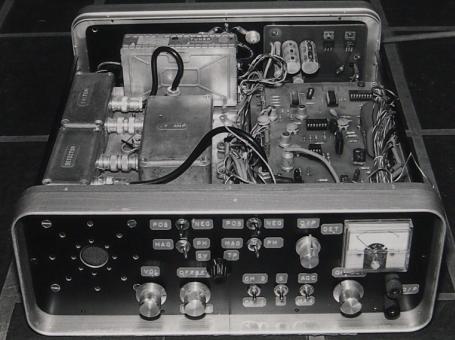
As a dual frequency radiometer the receiver is rapidly switched between 138 MHz and 228 MHz and at the same time the receiver input is switched between an 8 element 138 MHz yagi antenna (used in the polarimeter) and one of the 228 MHz yagis. This antenna switching function is implemented by using two DBM's in a changeover configuration (one of them is also used as the interferometer phase switch). The switching is carried out 125 times per second so that 125 samples proportional to the radio flux intensity at the two observing frequencies are available at the receiver detector each second. In effect the receiver is multiplexed to emulate the function of two separate receivers. Any number of receiving frequencies may be covered using this technique. The receiving frequencies used were chosen to suit readily available antennae and to allow drift rates for TYPE III bursts to be easily determined. The time delay was expected to be between 1 and 3 seconds at these frequencies.
The detector output is demultiplexed electronically and filtered to produce two separate outputs which are recorded on a reel to reel stereo recorder modified to accept low frequency data. The reason for using the tape recorder instead of a chart recorder for this mode is that high chart speeds would be required to achieve accurate time delay measurements which in turn requires a large amount of expensive recording paper. On the other hand, using a tape recorder, events can be selected from the tape for replay onto the chart recorder after the recording session. The chart speed can then be chosen to achieve accurate time delay measurements without wasting paper.
The polarimeter configuration uses an 8-element crossed yagi which consists of two identical linearly polarized yagis with the respective elements mounted at right angles. Equal length feedline connections are made to each antenna and one of the feedlines is extended by a quarter wavelength to provide the 90 degrees of phase shift required for the reception of circularly polarized radio waves. The interferometer phase switch supplies the additional 0 or 180 degrees of phase shift needed to alternately combine the antennae for the reception of either left or right circularly polarised waves. The receiver detector output is demultiplexed using the same circuitry as in the dual frequency mode. However the two outputs are now proportional to the intensity of the two circularly polarised components of the 138 MHz radio waves incident on the antenna. The outputs are recorded on a dual channel chart recorded.
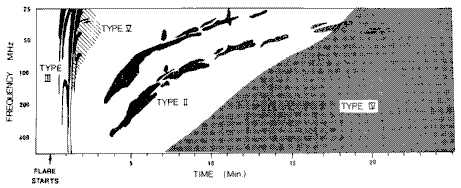
The radio telescope is switched on by a time clock for a total of four hours each day, two hours each side of local noon. The duration ot the monitoring period is dictated by the beamwidth of the antennae which are not steerable in hour angle. The radio telescope can operate unattended for a week or more unless a mode change is required or time delay measurements are being made.
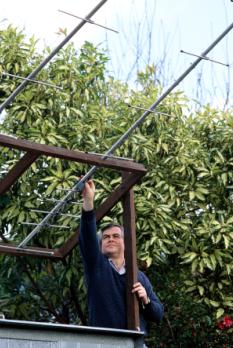 |
Figure A: The author (MHW) making adjustments to one of the 11 element yagi antennas of the phase switched interferometer used for making daily solar radio flux measurements. The antenna being adjusted, along with 3 identical antennas, form an array at the western end of the interferometer baseline while a single antenna is used at the eastern end. This antenna array also forms part of a dual frequency radiometer/polarimeter used to measure Type III radio burst arrival times at 228 and 138 MHz and wave polarisation at these same frequencies. This data was used to calculate the velocity of electron streams that generate Type III radio bursts in the solar corona. Combined half power beamwidth of the interferometer is approximately 25 degrees and gain of individual yagi antennas is 13dBd. |
SOLAR RADIO OBSERVING
Our observing programme is controlled by the results of both the optical observations which are taken at least once per week and the trend in the daily radio flux values measured with the radio telescope. When active regions are visible or periods of enhanced radiation are detected, additional measurements can be made to determine the nature and polarization of the radiation. These results are carefully recorded for later correlation with auroral sightings.
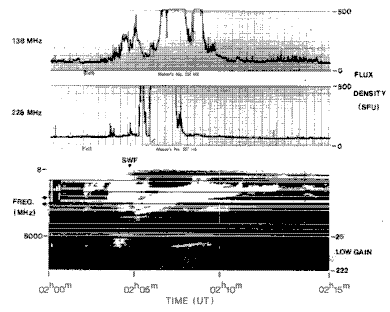
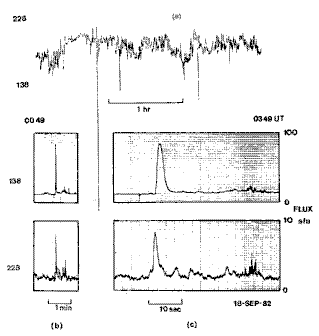
Using this observing protocol many of the basic findings of early solar radio observers were 're-discovered'. We found an association between the presence of active sunspot groups and increased radio burst activity. We were able to infer a connection between large sunspots and solar radio noise storms. We found that while noise storm radiation was consistently highly polarized at 138 MHz, TYPE III bursts at the same frequency exhibited a much smaller degree of polarization. The difference in these measurements supports the currently held view that TYPE I bursts are generated in regions of high magnetic field intensity, whereas TYPE III bursts tend to be to be generated in magnetically neutral regions such as are found within coronal streamers.
TYPE III and TYPE I bursts were by far the most commonly recorded bursts. As many as five or six TYPE III's were sometimes recorded during a single four hour recording period and if a noise storm was in progress many hundreds of TYPE I bursts were occasionally recorded over the same period.
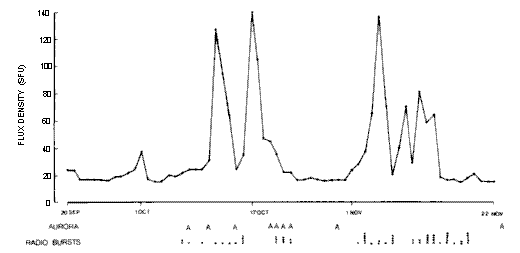
The average drift rate measured for ten isolated TYPE III bursts recorded in 1982 September was 50 MHz per second. By using a suitable model of the electron density distribution in a coronal streamer, we used this drift rate to calculate an exciter radial velocity of 77,600 km per second (0.26 c). It is not surprising that these energetic electron streams have been detected by satellites at least as far as Earth's orbit.
On 1982 August 8 a TYPE II burst was recorded using the dual frequency radiometer. This event was accompanied by a five minute short wave radio fadeout and was preceded by a group of TYPE III bursts. Interestingly no TYPE IV activity was observed following the TYPE II burst and we did not receive any auroral sightings over the following three days.
1981 was a particularly noteworthy year for auroral sightings, some 35 being reported by our Auroral section, the highest number for ten years, we noted that aurorae were more prevalent during times at which radio burst rates were high or noise storms were in progress, but the study of these correlations tends to be hampered by weather conditions which prevent auroral observations.
From the daily flux level measurements a baseline value was calculated (this is referred to as the quiet Sun flux) and used to calculate the apparent temperature of the quiet Sun. (The calibration was checked against the 245 MHz flux data provided by Learmonth Solar Observatory in Western Australia). These calculations gave a value of 1.38 million Kelvin, a value consistent with the known temperature of the corona (>l million Kelvin). Interestingly, fringe visibility measurements using the interferometer at different antenna spacings, gave a value of 0.85 degrees for the east-west solar diameter indicating that the radio waves being received at the observing frequency (228 MHz) were generated in the corona.
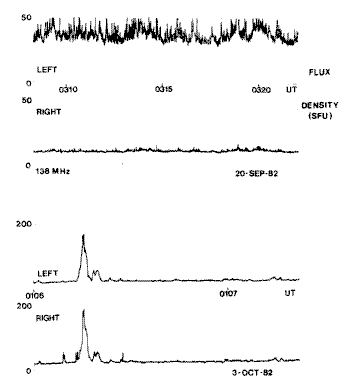
CONCLUSION
In conclusion, the ability to make the variety of observations described has considerably extended our personl understanding of solar phenomena. The inclusion of radio observations into the program significantly extended its scope by seemingly providing a missing link between the ever changing face of the visible Sun and the terrestrial effects observed. These observations are a clear revelation of the fact that the Earth is linked to the Sun by the invisible outflow of solar plasma appropriately termed the solar wind. The radio observations provide a 'window' into the corona making it possible to 'see' the normally invisible high energy phenomena which continuosly modulate this wind.
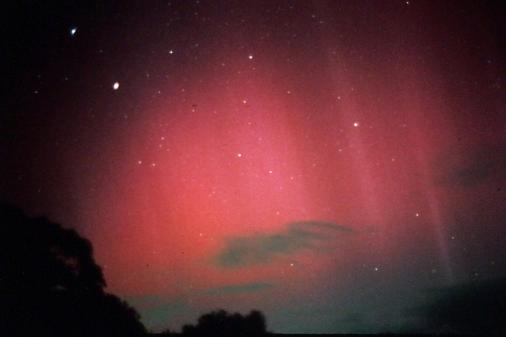
 Australian Space Academy
Australian Space Academy